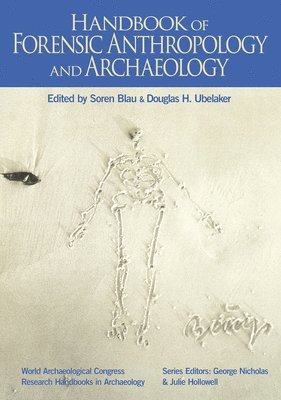
- Format
- Inbunden (Hardback)
- Språk
- Engelska
- Antal sidor
- 534
- Utgivningsdatum
- 2009-02-15
- Förlag
- Left Coast Press Inc
- Medarbetare
- Ubelaker, Douglas
- Illustrationer
- Illustrations
- Dimensioner
- 266 x 184 x 38 mm
- Vikt
- Antal komponenter
- 1
- ISBN
- 9781598740745
- 1292 g
Handbook of Forensic Anthropology and Archaeology
Kundrecensioner
Fler böcker av Joshua Blau
-
Phonology and Morphology of Biblical Hebrew
Joshua Blau
More than 80 years have passed since Bauer and Leander's historical grammar of Biblical Hebrew was published, and many advances in comparative historical grammar have been made during the interim. Joshua Blau, who has for much of his life been ass...
Recensioner i media
"...Forensic anthropologists play a pivotal role in disasters, and this volumepresents information on disaster science in general, the role of forensicanthropologists, and case studies of recent disasters.This is a fascinatingwork, important for students and experts alike in both archaeology andanthropology. Summing Up: Highly recommended."... --J. A. Gibson, CHOICE ... this volume is indeed comprehensive. The Editors should be congratulated on an excellent book, which should be on the bookshelf of any serious practitioner and library. The Editors state that the methodologies summarised in this volume are state of the art but hardly the last word.' However, this book should remain highly relevant for many years to come. Highly recommended!!"... - James Robertson, Australian Journal of Forensic Sciences
Övrig information
Soren Blau, B.A.(Hons.), M.Sc., Ph.D. has worked in the Centre for Human Identification (now Human Identification Services - HIS) at the Victorian Institute of Forensic Medicine (VIFM) as a forensic anthropologist since January 2005 and is currently the manager of the HIS. She is an honorary Senior Lecturer in the Department of Forensic Medicine at Monash University. Soren is involved in local and international casework as well as contributing to international Disaster Victim Identification (DVI) training courses. During her time at the VIFM, Soren has developed an interest in using computerized tomography (CT) data to establish population specific standards for forensic anthropology in Australia. She is currently coordinating a project in East Timor investigating alleged human rights abuses.|Douglas H. Ubelaker is a curator and senior scientist at the Smithsonian Institution's National Museum of Natural History in Washington, D.C. where he has been employed since about 1971. He received the PhD degree in 1973 from the University of Kansas. He has published extensively in the general field of human skeletal biology with an emphasis on forensic applications. Since about 1978, he has served as the primary consultant in forensic anthropology for the FBI Laboratory now located in Quantico, Virginia. In this capacity he has reported on over 780 cases and has testified in numerous legal proceedings
Innehållsförteckning
* Introduction, Soren Blau and Douglas UbelakerPart 1: History of the Disciplines* North American Perspectives* United StatesDouglas Ubelaker* CanadaMark Skinner and Kristina Bowie* Forensic Anthropology and Political Violence in South AmericaLuis Fondebrider* European Perspectives* United KingdomMargaret Cox* FranceEric Baccino* ItalyCristina Cattaneo* SpainJose Prieto* AustraliaDenise Donlon* IndonesiaEtty Indriati Part 2: Forensic Archaeology* The Search for and Detection of Human RemainsThomas D. Holland and Samuel V. Connell* Excavation and Recovery in Forensic Archaeological InvestigationsPaul N. Cheetham and Ian HansonPart 3: Forensic Anthropology* Differentiating Human from Non-Human Skeletal RemainsDawn Mulhern* Dating of Anthropological Skeletal Remains of Forensic InterestShari Forbes and Kimberly Nugent* Analysis of Commingled Human RemainsBrad Adams and John Byrd* Establishing a Biological Profile (ancestry, sex, age and stature)* The Assessment of AncestryNorman Sauer and Jane Wankmiller* Anthropological Estimation of SexValeria Silva Braz* Skeletal Age EstimationTracy Rogers* Histological Age EstimationChristian Crowder* Stature EstimationP. Willey* Trauma* Peri-mortem traumaLouise Loe* Antemortem TraumaEugenia Cunha and Joao Pinheiro* Forensic TaphonomyStephen P. Nawrocki* Burned Human RemainsTim Thompson* Craniofacial Identification: Techniques of Facial Approximation and CraniofaciaSuperimpositionCarl Stephan* Biomolecular ApplicationsLori Baker* Forensic OdontologyJohn ClementPart 4: The Crime and Disaster Scene: Case Studies in Forensic Archaeology and Anthropology* Domestic Homicide Investigations: United StatesDawnie Steadman, William Basler, Michael J. Hochrein, Dennis Klein, and Julia Goodin* Domestic Homicide Investigations in the UKJohn Hunter* Forensic Anthropology in Disaster ResponsePaul S. Sledzik* Medicolegal Investigations of Atrocities Committed During the Solomon Islands 'Ethnic Tensions'Melanie Archer and Malcolm Dodd* Disaster Anthropology: TsunamiSue Black* The Role of the Anthropologist in Disaster Victim Identification: The Bali Incidents 2002 and 2004 Bali Bombing, Chris Briggs and Alunah Buck* Investigation of Genocide and Crimes against Humanity* Dealing with the Remains of Conflict: An International Response to Crimes against Humanity, Forensic Recovery, Identification and Repatriation in the Former YugoslaviaJon Sterenberg* Forensic Anthropology and Archaeology in GuatemalaAmbika Flavel and Caroline Barker* Grave challenges in IraqDerek Congram and Jon SterenbergPart 5: The Professional Forensic Archaeologist and Forensic Anthropologist* More than just Bare Bones: Ethical Considerations for Forensic AnthropologistsSoren Blau* How to do Forensic Archaeology under the Auspices of Large Organizations like the United NationsRichard Wright and Ian Hanson* Contribution of Quantitative Methods in Forensic Anthropology: A New EraAnn Ross and Erin Kimmerle* The Expert Witness and the Court of LawMaciej Henneberg* Legal aspects of identificationDavid Ranson and Ian Freckleton* ConclusionGlobal Perspective on Issues in Forensic AnthropologyDouglas H. Ubelaker and Soren Blau
Du kanske gillar
-
Empire of AI
Karen Hao
Inbunden
